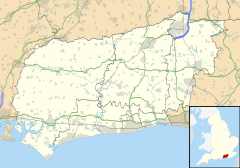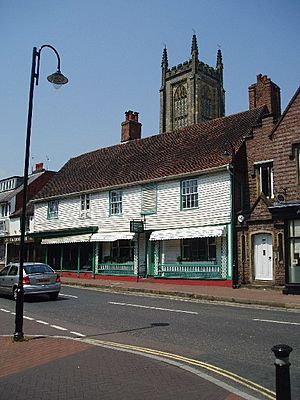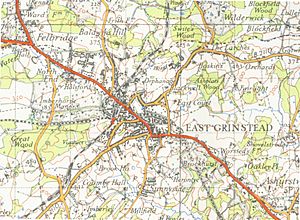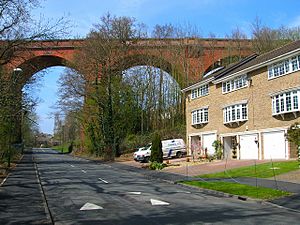East Grinstead facts for kids
Quick facts for kids East Grinstead |
|
|---|---|
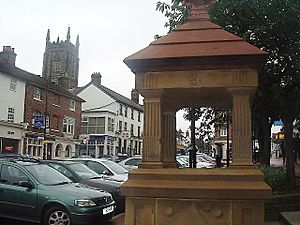 High Street |
|
| Area | 24.43 km2 (9.43 sq mi) |
| Population | 26,383 |
| • Density | 980/km2 (2,500/sq mi) |
| OS grid reference | TQ395385 |
| • London | 26 mi (42 km) N |
| Civil parish |
|
| District |
|
| Shire county | |
| Region | |
| Country | England |
| Sovereign state | United Kingdom |
| Post town | EAST GRINSTEAD |
| Postcode district | RH19 |
| Dialling code | 01342 |
| Police | Sussex |
| Fire | West Sussex |
| Ambulance | South East Coast |
| EU Parliament | South East England |
| UK Parliament |
|
East Grinstead is a town in West Sussex, England. It is close to the borders of East Sussex, Surrey, and Kent. The town is about 27 miles (43 km) south of London and 21 miles (34 km) northeast of Brighton.
East Grinstead covers an area of about 2,443.45 hectares (6,037.9 acres). In 2011, its population was 26,383 people. Nearby towns include Crawley and Horley to the west. Tunbridge Wells is to the east, and Redhill and Reigate are to the northwest. The village of Felbridge is right next to East Grinstead.
The town is located on the Greenwich Meridian, an imaginary line that divides the Earth into eastern and western hemispheres. East Grinstead has many old buildings. The beautiful Weald and Ashdown Forest areas are to the south-east.
Contents
Exploring East Grinstead
East Grinstead's High Street is famous for having one of the longest rows of 14th-century timber-framed buildings in England. These buildings are very old and show how people built homes centuries ago.
Historic Buildings and Sites
- Sackville College: This old building was built in 1609. It was an almshouse, a place where poor or elderly people could live. In 1853, John Mason Neale, who worked at the college, wrote the famous Christmas carol "Good King Wenceslas". From the college, you can see amazing views of Ashdown Forest.
- St Swithun's Church: Next to Sackville College is St Swithun's Church. It stands on the highest point in town. The church was rebuilt in the 1700s and its tower, built in 1789, is very tall. It can be seen from many miles away. In the churchyard, there is a memorial to the East Grinstead Martyrs. These people were burned at the stake in 1556 for their Protestant beliefs.
- East Court Mansion: This historic mansion was built in 1769 and is now home to the Town Council. The Greenwich Meridian runs through its grounds. This means you can stand with one foot in the eastern hemisphere and one in the western! The mansion is set in a lovely park.
- Hammerwood Park: About Three miles (5 km) east of town is Hammerwood Park. This country house was built in 1792. It was once owned by the famous rock band Led Zeppelin.
- Standen: On the edge of town, you'll find Standen, a country house owned by the National Trust. It has a fantastic collection of items from the Arts and Crafts movement, including furniture and fabrics.
East Grinstead During World War II
East Grinstead played a very special role during the Second World War.
- Queen Victoria Hospital: The Queen Victoria Hospital became famous for its special burns unit. Sir Archibald McIndoe led this unit. He was a pioneer in reconstructive plastic surgery. Many RAF and Allied airmen who were badly burned or injured were treated here.
- The Guinea Pig Club: In 1941, patients treated by McIndoe formed the Guinea Pig Club. This club helped the airmen and their families. The townspeople of East Grinstead were incredibly supportive of these patients. Even though many had severe injuries, the locals treated them with kindness. They invited them to dinner and made them feel normal. This is why East Grinstead is known as "The town that did not stare."
- The 1943 Air Raid: On July 9, 1943, a Luftwaffe bomber dropped eight bombs on the town. Two bombs hit the Whitehall Theatre, a cinema. Many people were watching a film, including children who were evacuees. A total of 108 people died, and 235 were injured. This was the biggest loss of life from a single air raid in Sussex.
- McIndoe Memorial: On June 9, 2014, a monument to Sir Archibald McIndoe and the Guinea Pigs was unveiled. It stands in front of Sackville College. The statue shows a burned airman looking up, with McIndoe's hands on his shoulders. A stone ring around the statue lets visitors sit and remember.
Museums and Arts
- East Grinstead Museum: In 2006, the East Grinstead Museum moved to a new building in the town center. It shares the history of East Grinstead with visitors.
- Chequer Mead Theatre: This modern theatre has 320 seats. It hosts many shows, including plays, musicals, concerts, opera, and ballet. It also has a popular cafe.
Nature and Parks
East Grinstead is close to Ashdown Forest. It also has the Forest Way and Worth Way. These are linear country parks built on old railway lines. They are great for walking and cycling and are part of the Sustrans national cycle network.
Places of Worship
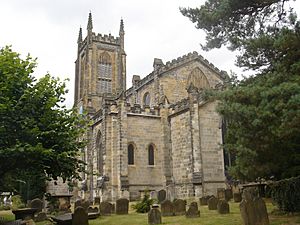
East Grinstead has many different religious groups for a town of its size.
Christian Churches
- Church of England: There are four Church of England churches. St Swithun's Church is the oldest, founded in the 11th century. Near its entrance, three stones mark where the East Grinstead Martyrs were burned. Other Church of England churches include St Luke's, St Barnabas', and St Mary the Virgin.
- Nonconformist Churches: These are Protestant churches that are not part of the Church of England. The first was Zion Chapel, built in 1810. It is now called West Street Baptist Church. There is also Trinity Methodist Church and the Moat Church, which is a United Reformed Church.
- Roman Catholic Church: Roman Catholics worship at the Church of Our Lady and St Peter, built in 1898.
Other Religions
- The Church of Jesus Christ of Latter-day Saints: The local meetinghouse was built in 1985. The London England Temple of the Church of Jesus Christ of Latter-day Saints is also nearby in Newchapel.
- Church of Scientology: The UK headquarters of the Church of Scientology is at Saint Hill Manor on the edge of East Grinstead. L. Ron Hubbard, who founded Scientology, bought the mansion in 1959 and lived there for several years.
- Jehovah's Witnesses: They have a modern Kingdom Hall in the town.
Town Development Plans
The East Grinstead Town Centre Master Plan was approved in 2006. It aims to improve and update the town center over many years.
Getting Around East Grinstead
Air Travel
Gatwick Airport is only about 10 miles (16 km) from East Grinstead. Redhill Aerodrome and Biggin Hill Airport are also close by.
Train Travel
East Grinstead station became the end of the line in 1967. This happened when many railway lines were closed down based on a report by Dr Richard Beeching. The line to Lewes closed earlier, in 1958.
Part of the old railway line is now a road called "Beeching Way." It's nicknamed "Beeching Cut" because it runs through a cutting. Much of the old railway tracks are now walking and cycling paths called the Worth Way and Forest Way.
The Bluebell Railway, a preserved steam railway, has rebuilt part of the old line to Lewes. The first passenger train from East Grinstead on this restored line ran on March 23, 2013.
Road Travel
East Grinstead is located where the A22 and A264 roads meet. For a short distance, these two main roads use the same stretch of road, which can cause traffic. The town is within easy driving distance of London (about 30 miles (50 km)) and Crawley/Gatwick (about 10 miles (16 km)). Many people who live in East Grinstead travel to Crawley and Gatwick for work.
Schools in East Grinstead
East Grinstead has both state-funded and independent schools. West Sussex County Council runs seven primary schools and two secondary schools. All these schools teach both boys and girls.
State Secondary Schools
Preparatory Schools
Twin Towns
East Grinstead is twinned with several towns in other countries. This means they have special friendly relationships.
- Bourg-de-Péage, France
- Sant Feliu de Guíxols, Spain
- Mindelheim, Germany
- Schwaz, Austria
- Verbania, Italy
Sports and Clubs
East Grinstead has many sports and social clubs.
- King George's Field: This land was given to the town by a local person and named after King George V. The King's Centre leisure center is here, with an indoor swimming pool, gym, and sports hall.
- Other Facilities: You can find tennis courts and a bowling green at Mount Noddy. East Court has tennis courts and pitches where the football club East Grinstead Town F.C. plays.
- Athletics: East Grinstead AC is an athletics club that trains at Imberhorne School.
- Rugby: East Grinstead Rugby Football Club has teams for all ages, from Under 7s to adults.
- Hockey and Lacrosse: The town is also home to East Grinstead Hockey Club and East Grinstead Lacrosse Club.
- Running: East Grinstead Runners meet regularly for training and social runs around the town's trails.
Media
Newspapers
East Grinstead has two weekly newspapers: the East Grinstead Courier and the East Grinstead Gazette.
Television
Local news and TV shows come from BBC South East & BBC London (on BBC One) and ITV Meridian & ITV London (on ITV).
Radio
You can listen to BBC Radio Surrey and BBC Radio Sussex. Other stations include Heart South, Greatest Hits Radio South, and 107 Meridian FM, which is a local community radio station.
Freedom of the Parish
This is a special honor given to people or groups who have done a lot for the town.
- Reverend Canon Clive Everett-Allen received this honor on April 7, 2015.
 |
Horley | Lingfield | Edenbridge |  |
| Crawley Down, Crawley | Hammerwood | |||
| Haywards Heath | Ashurst Wood | Forest Row, Crowborough |
See also
In Spanish: East Grinstead para niños


